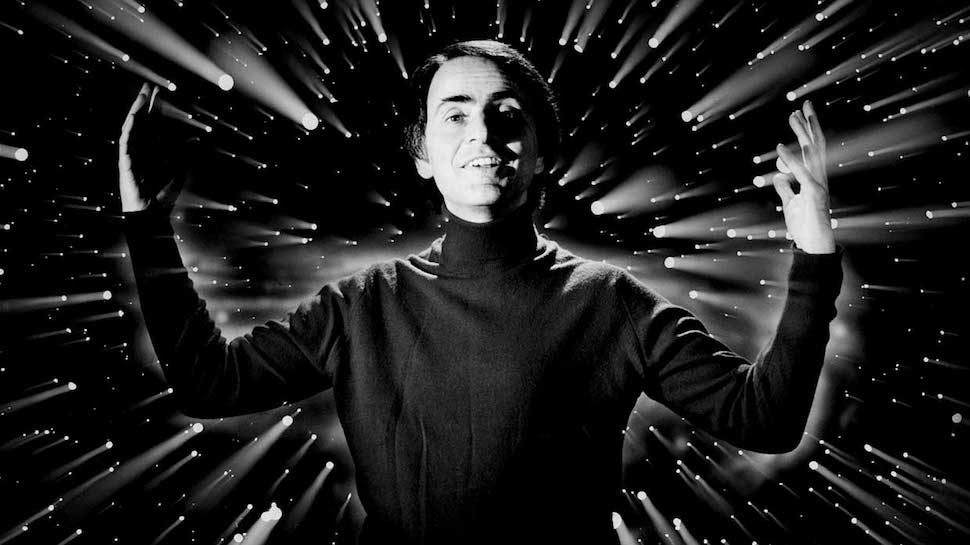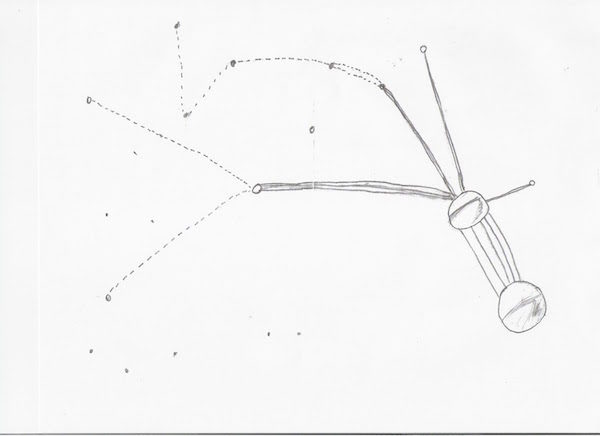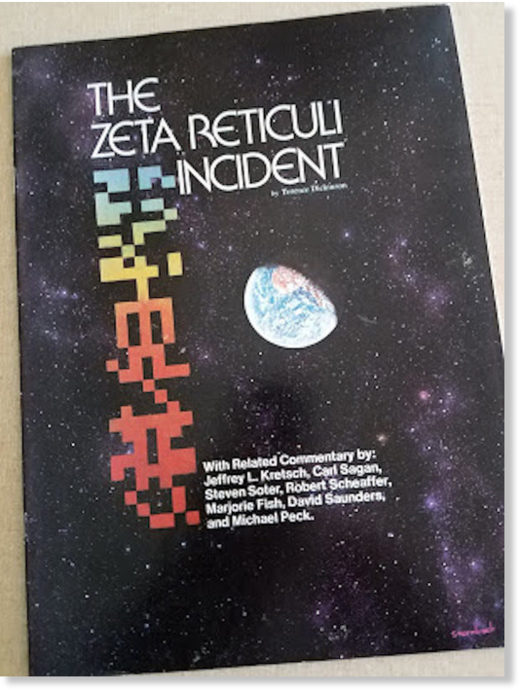And he REALLY hated star maps...
Many of you know the Marjorie Fish story, so I'll just give you the basics to recap (or you can go to page 213 in your heavily dog-eared copy of my J. Allen Hynek biography The Close Encounters Man and read about it there):
When Betty Hill and her husband Barney were allegedly abducted by aliens and taken aboard a UFO in 1961, Betty asked one of her alien captors from where he and his crew had come. The alien "Leader" showed Betty a star map of his race's trading and exploration routes (a map that the podcasters on Oh No Ross and Carrie hilariously think looks suspiciously like a sex organ), but the alien did not point out to Betty which was his home star.
Years later Betty Hill recreated the map under hypnosis, and the map was reproduced in a popular book about the Hills' experience, John Fuller's The Interrupted Journey. An Ohio school teacher named Marjorie Fish read the book, saw the map, and decided, as I describe in my book, to give Betty's map "the Rand McNally treatment." That's about as far as the story goes in my book, because, as I said, I had to edit out a lot of Fish's story in the final cut.
But here, I am free to tell the whole story, and to use as many words as I damn well please with which to tell it:
Oscar-winning actress Geena Davis; best-selling author Jean Auel; international concert pianist Patricia Jennings; former Playboy "Playmate" Dr. Julie Peterson; what do they all have in common? All four belong to Mensa, the international society whose only entrance requirement is that members possess an IQ in the top two percent of the population.###
Add to this exclusive group of geniuses Marjorie Fish, the Ohio schoolteacher who had become so fascinated by the star map dawn from memory under hypnotic suggestion by UFO abductee Betty Hill. Since she had first seen the map in John Fuller's account of the Hill abduction, "The Interrupted Journey," Fish had wondered whether the stars on the map might be plotted and identified. It seemed possible, if one assumed that our sun was one of the stars depicted on the map, and if one could pinpoint the exact point in space from which the stars on the map aligned in just the way Betty Hill remembered them. It seemed possible, but perhaps only to a Mensa member.
Imagine taking on such a project without an observatory, without a computer, equipped with little more than marbles, beads, string, glue, tape, a catalog of stars, the generous advice of some friendly local astronomers, a genius IQ and a boundless sense of determination. By any objective measurement, it was a ponderous, tedious, mind-boggling task. Fish would be working with scant, possibly unreliable information, remembered under hypnosis by Betty Hill years after she claimed to have seen the map. In addition to the essential assumption that one of the stars on the alien's map was actually our own sun, she would be making endless assumptions about the likelihood of whether any neighboring stars had planets, whether those planets could support life, whether traversing interstellar space was even remotely possible, whether the stars were even in the Milky Way galaxy. Nearly everything was stacked up against her. She should have failed.
In August of 1969, Fish visited Betty Hill in New Hampshire to better understand the conditions under which Betty saw the map, and those under which she recalled and drew the map. Among other things, Fish learned that Betty's drawing was made under exceedingly strict post-hypnotic guidelines administered by Dr. Simon: she could only draw the map once she fully remembered it, and she could not pay attention to what she was drawing. Betty told Fish that when she was able to draw the map, she broke the post-hypnotic directive twice, consciously erasing and correcting errors.
Fish returned home and she went to work.
"Marjorie Fish constructed several three-dimensional models of the solar neighborhood in hopes of detecting the patterns in the Hill map," wrote the editor of Astronomy magazine. "Between Aug. 1968 and Feb. 1973, she strung beads, checked data, searched and checked again. A suspicious alignment, detected in late 1968, turned out to be almost a perfect match."
But, there was a twist: it was only recognized as a match once information from a 1969 stellar catalog became available, at which time several unknown stars drawn in by Betty Hill in 1964 were finally identified. It seemed that either Betty Hill was a time traveler, or she was privy to information in 1964 that no astronomer on earth knew.
Carl Sagan was fond of dismissing the UFO phenomenon with the saying, "extraordinary claims require extraordinary evidence," and here was something rather extraordinary. Fish identified the vantage point of the map as being 55 light years away from our solar system. She identified the main, foreground stars on the map as Zeta Reticuli One and Two; one of them would, presumably, be the home of the Hills' aliens. She identified our sun as one of the stars on what the alien Leader had identified as an "exploration" route, as opposed to a trade route. She identified 16 stars from the aliens' map whose arrangement from her chosen point of view lined up very closely with Betty's stars. And two of the stars Betty Hill had placed on the map, and for which Fish was able to account weren't even listed on official star catalogs, and wouldn't be for another year. It was an extraordinary display of speculative spatial reasoning on Fish's part, and a plausible verification of Betty Hill's map.
"Since we did not have the data to make such a map in 1961 when Betty saw it, or in 1964 when she drew it, it could not be a hoax," Fish said in an address to a 1974 UFO Symposium. "Since the stars with lines to them are such a select group, it is almost impossible that the resemblance between Betty's map and reality could be coincidental. Betty's map could only have been drawn after contact with extraterrestrials."
This, of course, assumes that Fish's star identifications were correct, which Fish and several brave scientists believed. Dr. David Saunders, late of the Condon Committee, said, "I can find no major point of quibble with Marjorie Fish's interpretation of the Betty Hill map," while Walter Mitchell, a professor of astronomy at Ohio State, said, "The more I examine it, the more I am impressed by the astronomy involved in Marjorie Fish's work."
When Astronomy Magazine editor Terence Dickinson penned a fair-minded article expressing genuine curiosity about Fish's findings, quoting Saunders, Mitchell, and many more supporters of Fish's detective work, he sparked a full year of ferocious debate in his magazine. "The Zeta Reticuli Incident," Dickinson's article, "sparked more interest among our readers than any other single article in Astronomy" wrote Jeffrey L. Kretsch in a follow-up piece.
"The pattern discovered by Marjorie Fish has an uncanny resemblance to the map drawn by Betty Hill," wrote Dickinson. "(T)he stars are mostly the ones that we would visit if we were exploring from Zeta Reticuli, and the travel patterns generally make sense."
"In general, the entire sequence of events just does not smell of falsification," Dickinson wrote. "Coincidence, possibly; hoax, improbable." And, while Dickinson felt that the evidence did not support any firm conclusions, he felt that the only response to Fish's findings was to "continue the search."
In his article, "The Age of Nearby Stars," Kretsch, a graduate student of Hynek's, wrote that "In her analysis, Ms. Fish linked all 16 prominent stars in the original map... to 15 real stars in the southern sky. The congruence was remarkable."
"(W)e are confronted with evidence which seems to raise as many questions as it answers," Kretsch concluded. "But the search for answers to such questions certainly can only advance knowledge of our cosmic environment."
This did not sit well with Carl Sagan, who, with graduate assistant Steven Soter, wrote a rebuttal to Astronomy Sagan and Soter felt that Marjorie Fish and the editors of Astronomy had used shoddy research methods and had "contrived a resemblance" between two "nearly random data sets." In other words, Fish had fooled herself, seeing a resemblance that was purely coincidental, and Astronomy had in turn been bamboozled by her mistake.
Sagan and Soter made no secret of their disdain for the Betty and Barney Hill abduction story in general and found it "riddled with internal and external contradictions." For Sagan, this was crucial. If he were to allow any possibility that Marjorie Fish's conclusion had even the slightest validity, then he would also have no choice but to allow that the Hill's story of alien abduction had some validity as well. Ergo, Sagan could never, under any circumstances, bestow any validity to Fish's findings. He simply had to find a way to condemn Fish's work that would stick; the trouble was, one can't blithely accuse a Mensa member of being deluded, or of hallucinating.
Astronomy editor Dickinson defended his article, stating that Sagan and Soter were wrong to reduce the problem to simple "pattern resemblance." He insisted that his examination of the case had indeed been rigorous, and reminded his readers that Marjorie Fish had considered, then rejected, many possible patterns before finding her possible match. "The fact that she came up with a pattern that fits as well as it does is a tribute to her perseverance and the accuracy of the models," Dickinson wrote.
Replies in the next issue from Dr. David Saunders and Northwestern graduate student Michael Peck countered Sagan's and Soter's assertions with a barrage of dense mathematical and statistical calculations that led Saunders to conclude that "I continue to find the star map results exceedingly interesting," and Peck to claim "We can conclude... that the degree of resemblance between the two maps is fairly high."
By the time Sagan and Soter responded to Dickinson, Saunders and Peck, the argument had reached epic proportions. Had they simply ignored Dickinson's original article, the matter would likely have been all but forgotten in a matter of weeks, but Sagan and Soter seemed determined to keep the issue alive. In their latest tome, the two accused Saunders and Peck of falling victim to statistical fallacies - knowing full well that Saunders taught statistical analysis at the University of Chicago-and concluded emphatically that, "(T)he Zeta Reticuli argument and the entire Hill story do not survive critical scrutiny."
Next up in Astronomy, NASA computer expert Robert Scheaffer argued, quite oddly, that because the Hill map could be said to resemble three different local star patterns-and that more were likely to be discovered in the future - Fish was mistaken in claiming that it resembled any one particular pattern.
The editorial battle reached its zenith with a strenuous response by Marjorie Fish herself. Fish, who now worked as a research assistant at Oak Ridge National Laboratory in Tennessee, argued that Scheaffer had, like Sagan and Soter before him, ignored the fact that her stars had not been randomly selected. She had, in fact, considered only stars that fit very specific characteristics, such as their probability of having planets. "My final interpretation of the map was the only one I could find where all the restrictions outlined above were met."
It's impossible to know whether any inquiring minds were changed, one way or another, by the long-playing war of words in Astronomy, but the episode certainly illustrates the lengths to which scientists will go to defend their own particular interpretations of difficult data.
My source for this material is a 32-page, full-color publication titled "The Zeta Reticuli Incident," a collection of reprints of the articles, editorials and rebuttals surrounding Fish's decoding of the Betty Hill star map, published by Astronomy in 1976 (at one point Dr. Sagan is said to have threatened to sue the magazine for reprinting his letters without permission). So, now you know the whole story, and I wonder if your mind is changed by the truth?
Oh, one more thing: I contacted the one of the current editors of Astronomy Magazine for her take on this controversy, and here's her reply:
Unfortunately, there is no staff members [sic] around from that period of time. As for Terence Dickinson, I don't have any contact information for him.That's a damn shame, because I would love to know what Mr. Dickinson thinks about "The Zeta Reticuli Incident" now...






Reader Comments
BUT Its not an easy situation to be in:
A: Tell the truth and suffer greatly
B: Tell the lie and profit handsomely
We know what his choice was.
In all his rhetoric he would imply ufo's are bogus, but do keep looking! because there is stuff out there...
All this story is missing is "Houdini" came back & told me...Maybe Sagan couldn't stand UFO assumptions...little Green men...The Blob...general claims of UFO's for the same reason as he couldn't stand the Astrology BS...
But people are drawn to belief systems the mystical & unexplained and like flies they swarm in to the smell of BS...
Ain't it sweet...